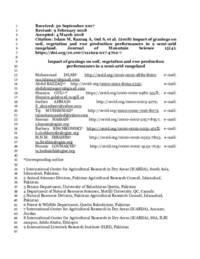Impact of grazing on soil, vegetation and ewe production performances in a semi-arid rangeland

Authors:
Controlled grazing is considered a good management strategy to maintain or increase the live weight of livestock and to reduce vegetation degradation of rangelands. The present study investigated soil characteristics, aboveground vegetation biomass dynamics and controlled grazinginduced changes in the live weight of local ewes in the semi-arid rangeland of Ahmadun, Ziarat, Balochistan province of Pakistan. An area of 115 ha was protected from livestock grazing in April 2014. In June 2015, soil characteristics within 0-30 cm depth i.e. soil organic matter (SOM), mineral nitrogen, pH and texture in controlled and uncontrolled grazing sites were assessed. Aboveground vegetation biomass measured in early (June) and late summer (August) in 2015 and 2016. The nutritional value i.e. crude protein, phosphorus (P), neutral detergent fiber (NDF), acid detergent fiber (ADF), calcium (Ca), magnesium (Mg) and potassium (K) of dominant plant species were assessed at the beginning of experiment in 2015. Vegetation cover of controlled and uncontrolled grazing sites was also measured during the two years of the study period using the VegMeasure software. From June to November in 2015 and 2016, controlled and uncontrolled livestock grazing sites were grazed on a daily basis by local ewes with a stocking rate of 2 and 1 head ha-1 respectively. Results reveal that the organic matter contents of coarse-textured, slightly alkaline soil of the study site were in the range of 9.4 - 17.6 g kg-1 soil and showed a strong positive correlation with aboveground vegetation biomass. The biomass of plants was 56.5% and 33% greater at controlled than uncontrolled grazing site in 2015 and 2016 respectively and plant cover was also higher at controlled than uncontrolled grazing site in both years. The nutrient contents were significantly (P<0.05) lower in grasses than shrubs. In both years, the controlled grazing increased the weight gain of ewes about two folds compared to the uncontrolled grazing. The results indicate that controlled grazing improved the vegetation biomass production and small ruminant productivity.
